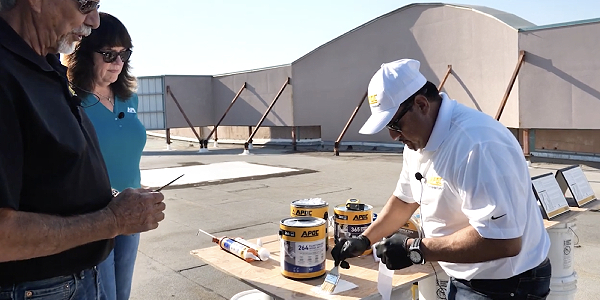3 key tests to do when you get on a roof

By Emma Peterson.
Join experts from APOC on the roof as they walk through the first steps of a coating project.
In this unique CoatingsTalk, Heidi J. Ellsworth climbed onto a roof with APOC’s John Athanasion and Mike Negrete! The trio took a walk around the space to see how John and Mike identify common problem areas and what best practices are for dealing with them in the field. One of the big things that they spoke about was proper preparation before starting the project. A big part of this preparation is making sure you have a full understanding of the current state of the roof, which you can find out through some key tests!
1 - Moisture tests
One of the common issues on roofs with older coatings is moisture intrusion. When water gets underneath the membrane, it can soak into the plywood and cause structural damage to the roof. When you’re prepping, look for visual signs of this type of damage. John pointed out that you can often see staining from where ponding water has been. In addition to this, you can do a moisture test. Mike explained, “When you do that, try to do it on the highest surface so you can be safe. You can patch that area. You have to look at that before you decide what kind of system you can put down.”
2 - Core tests
Another important aspect to investigate while on the roof for the first time is its history of coatings. John explained, “It's very important to do a core test on these things to determine if you have one, two or three layers on them before you actually determine what system you're going to use.”
3 - Pull tests
This is another crucial test and for this special episode of CoatingsTalk, Mike performed one live! John explained what he was doing, saying, “He’s using APOC number 264. It's a white acrylic mastic, and this is what you use on any of your acrylic systems here. What Mike's going to do is put the polyester in there, you embed it into the polyester and then do a light brushing on top. You're going to leave about two or three inches out on a tail.” This would sit for two to three days before you would come and pull it to see if it properly adheres to the existing membrane. For all of these tests, but especially this one, John made sure to emphasize the importance of documentation. He shared, “Contractors should actually take a picture of it when they're doing a pull. That way you can document this in your contract.”
Read the transcript, Listen to the podcast or Watch the webinar to see some of these tests in action and learn more tips and tricks for starting a coating project!
Learn more about APOC in their Coffee Shop Directory or visit www.apoc.com.

About Emma
Emma Peterson is a writer at The Coffee Shops and AskARoofer™. Raised in the dreary and fantastical Pacific Northwest, she graduated in 2024 from Pacific University in Oregon with a degree in creative writing and minors in graphic design and Chinese language. Between overthinking everything a little bit, including this bio, she enjoys watching movies with friends, attending concerts and trying to cook new recipes.
Recommended For You

RoofersCoffeeShop® Partners With John Kenney to Provide Safety Trainings
Read More ...
Trade Association Coalition Announces Q3 Findings from Market Index Survey for Reroofing
Read More ...
IIBEC Pivots to a Virtual 2020 International Convention and Trade Show June 12-14; Announces BES+ in November
Read More ...


















Comments
Leave a Reply
Have an account? Login to leave a comment!
Sign In